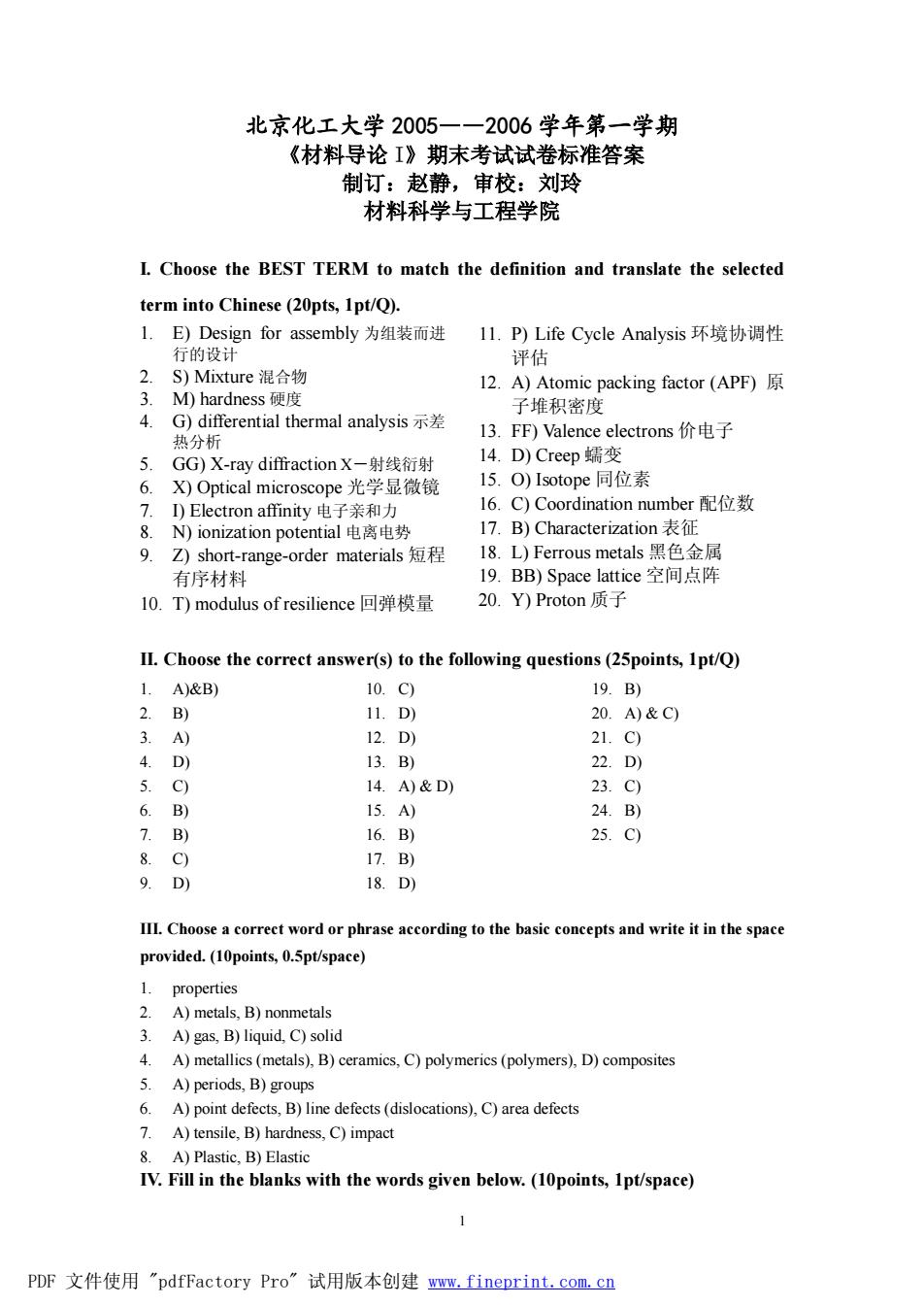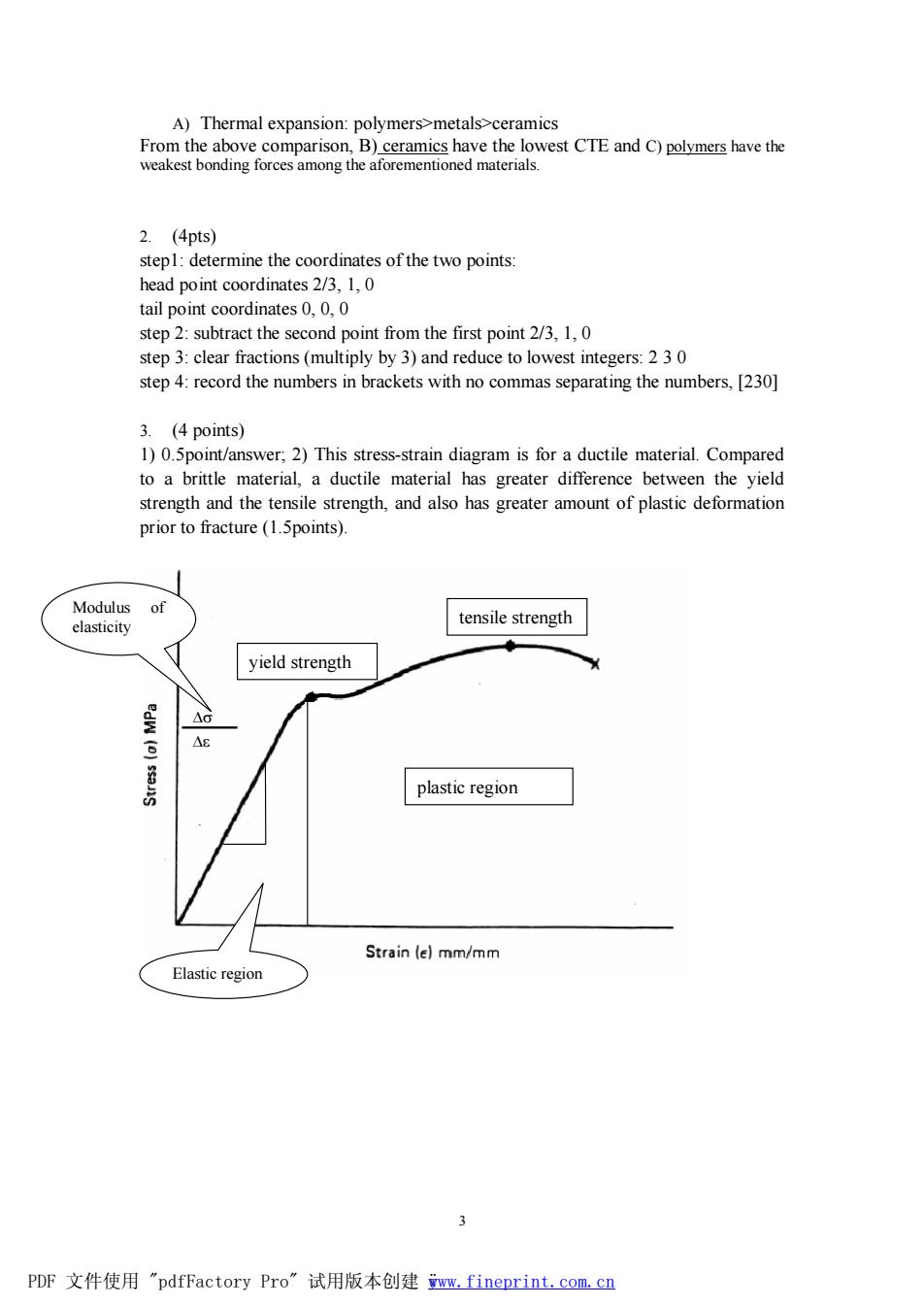
北京化工大学2005一一2006学年第一学期 《材料导论I》期末考试试卷标准答案 制订:赵静,审校:刘玲 材料科学与工程学院 I.Choose the BEST TERM to match the definition and translate the selected term into Chinese(20pts,1pt/Q) L.E)Design for assembly为组装而进Il.P)Life Cycle Analysis环境协调性 行的设计 评估 2.S)Mixture混合物 12.A)Atomic packing factor(APp)原 3. M)hardness使度 堆积密 4. G)differential thermal analysis示差 l3.FF)Valence electrons价电子 热分析 5 14.D)Creep播变 GG)X-ray diffractionX-射线衍射 6. X)Optical microscope光学显微镜 15.O)Isotope同位素 7.)Electron affinity电子亲和力 16.C)Coordination n mber配位数 N)ionization potential电离电势 17.B)Characteriza 9. Z)short--range-order materials短程 l8.L)Ferrous metals黑色金 有序材料 l9.BB)Space lattice空间点E l0.T)modulus of resilience回弹模量 20.Y)Proton质子 II.Choose the correct answer(s)to the following questions(25points,Ipt/Q) 1.A)&B) 10.C) 19.B) B) 11.D 20.A)&C 12 D) 21.C 13.B 22.D 5.C) 14.A)&D 23.C) 6. 15.A) 24.B) 7 B 16.B) 25.C) 17.B) 9 18.D III.Choose a correet word or phrase according to the basic concepts and write it in the space provided.(10points,0.5pt/space) properties A)metals B)nonmetals A)gas.B)liq uid C)s A)metallics(metals),B)ceramics,C)polymerics(polymers),D)composites 5. A)periods,B)groups 6.A)point defects,B)line defects(dislocations),C)area defects 7.A)tensile.B)hardness.C)impact 8 A)Plastic B)Elastic IV.Fill in the blanks with the words given below.(10points,Ipt/space) PDF文件使用"pdfFactory Pro”试用版本创建,fineprint,com,cn
1 北京化工大学 2005——2006 学年第一学期 《材料导论 I》期末考试试卷标准答案 制订:赵静,审校:刘玲 材料科学与工程学院 I. Choose the BEST TERM to match the definition and translate the selected term into Chinese (20pts, 1pt/Q). 1. E) Design for assembly 为组装而进 行的设计 2. S) Mixture 混合物 3. M) hardness 硬度 4. G) differential thermal analysis 示差 热分析 5. GG) X-ray diffraction X-射线衍射 6. X) Optical microscope 光学显微镜 7. I) Electron affinity 电子亲和力 8. N) ionization potential 电离电势 9. Z) short-range-order materials 短程 有序材料 10. T) modulus of resilience 回弹模量 11. P) Life Cycle Analysis 环境协调性 评估 12. A) Atomic packing factor (APF) 原 子堆积密度 13. FF) Valence electrons 价电子 14. D) Creep 蠕变 15. O) Isotope 同位素 16. C) Coordination number 配位数 17. B) Characterization 表征 18. L) Ferrous metals 黑色金属 19. BB) Space lattice 空间点阵 20. Y) Proton 质子 II. Choose the correct answer(s) to the following questions (25points, 1pt/Q) 1. A)&B) 2. B) 3. A) 4. D) 5. C) 6. B) 7. B) 8. C) 9. D) 10. C) 11. D) 12. D) 13. B) 14. A) & D) 15. A) 16. B) 17. B) 18. D) 19. B) 20. A) & C) 21. C) 22. D) 23. C) 24. B) 25. C) III. Choose a correct word or phrase according to the basic concepts and write it in the space provided. (10points, 0.5pt/space) 1. properties 2. A) metals, B) nonmetals 3. A) gas, B) liquid, C) solid 4. A) metallics (metals), B) ceramics, C) polymerics (polymers), D) composites 5. A) periods, B) groups 6. A) point defects, B) line defects (dislocations), C) area defects 7. A) tensile, B) hardness, C) impact 8. A) Plastic, B) Elastic IV. Fill in the blanks with the words given below. (10points, 1pt/space) PDF 文件使用 "pdfFactory Pro" 试用版本创建 www.fineprint.com.cn

L.A)amorphous,B)crystalline答案与顺序无关 2. A)allotropic,B)polymorphic vacancy 5.interstitial 6 substitutional 7 Mohs test 8. torsional yield strength Scleroscope(HSc)test 10.Alkanes V.True or false questions.If you think the statement is true,write the letter"T"; otherwise,write the letter"F"(15points,Ipt/Q) 1.F 6.F 11.T 2F 7.F 12F 3.T 8.F 13.T 4.T 9.T 14.T 5 10.F 15.F VI.Give a simple answer to the following questions(10points) 1.(3points) There are seven crystal systems and atoms can form total 14 Brevais lattices with these seven crystal systems.There are three types of unit cell for cubic crystal system,including simple cubic unit cell (sc).body-centered cubic unit cell (bcc).and face-centered cubic unit cell (fcc) 2.(3points) The two methods of measuring ductility are and percent reduction inarea. eotio(where is the length at fracture,o isthe original lengh %reduction in area=(AA100%)/A0,where A:is the cross-sectional area at fracture,Ao is the original cross-sectional area. A material that has 5%or less elongation is considered as a brittle material. 3. (3points) When it is heated deliberately,the metal rod will absorb heat,expand and transfer heat.The absorption of heat,thermal expansion and heat transmission are characterized by specific heat, coefficient of (linear)thermal expansion and thermal conductivity.respectivelv. 4.(Ipoints) The amount of creep and springback VII.Complex questions.(10points) 1.(2pts) PDF文件使用"pdfFactory Pro”试用版本创建w,fineprint,con.cn
2 1. A) amorphous, B) crystalline 答案与顺序无关 2. A) allotropic, B) polymorphic 3. interstitialcy 4. vacancy 5. interstitial 6. substitutional 7. Mohs test 8. torsional yield strength 9. Scleroscope (HSc) test 10. Alkanes V. True or false questions. If you think the statement is true, write the letter “T”; otherwise, write the letter “F” (15points, 1pt/Q) 1. F 2. F 3. T 4. T 5. T 6. F 7. F 8. F 9. T 10. F 11. T 12. F 13. T 14. T 15. F VI. Give a simple answer to the following questions (10points) 1. (3points) There are seven crystal systems and atoms can form total 14 Brevais lattices with these seven crystal systems. There are three types of unit cell for cubic crystal system, including simple cubic unit cell (sc), body-centered cubic unit cell (bcc), and face-centered cubic unit cell (fcc). 2. (3points) The two methods of measuring ductility are percent elongation and percent reduction in area. % elongation=( (lf-l0)×100%)/l0, where lf is the length at fracture, l0 isthe original length % reduction in area=(A0-Af)×100%)/A0, where Af is the cross-sectional area at fracture, A0 isthe original cross-sectional area. A material that has 5% or less elongation is considered as a brittle material. 3. (3points) When it is heated deliberately, the metal rod will absorb heat, expand and transfer heat. The absorption of heat, thermal expansion and heat transmission are characterized by specific heat, coefficient of (linear) thermal expansion and thermal conductivity, respectively. 4. (1points) The amount of creep and springback. VII. Complex questions. (10points) 1. (2pts) PDF 文件使用 "pdfFactory Pro" 试用版本创建 www.fineprint.com.cn

A)Thermal expansion:polymers>metals>ceramics From the above comparison,B)ceramics have the lowest CTE and C)polymers have the weakest bonding forces among the aforementioned materials. 2.(4pts) stepl:determine the coordinates of the two points: head point coordinates 2/3,1,0 tail point coordinates 0.0.0 step 2:subtract the second point from the first point 2/3,1,0 step 3:clear fractions(multiply by 3)and reduce to lowest integers:230 step 4:record the numbers in brackets with no commas separating the numbers,[230] 3. (4 points) 1)0.5point/answer;2)This stress-strain diagram is for a ductile material.Compared to a brittle material,a ductile material has greater difference between the yield strength and the tensile strength,and also has greater amount of plastic deformation prior to fracture (1.5points). Modulus 0时 elasticity tensile strength yield strength 4 6 plastic region Strain (e)mm/mm Elastic region PDF文件使用"pdfFactory Pro”试用版本创建ww,fineprint.com,cn
3 A) Thermal expansion: polymers>metals>ceramics From the above comparison, B) ceramics have the lowest CTE and C) polymers have the weakest bonding forces among the aforementioned materials. 2. (4pts) step1: determine the coordinates of the two points: head point coordinates 2/3, 1, 0 tail point coordinates 0, 0, 0 step 2: subtract the second point from the first point 2/3, 1, 0 step 3: clear fractions (multiply by 3) and reduce to lowest integers: 2 3 0 step 4: record the numbers in brackets with no commas separating the numbers, [230] 3. (4 points) 1) 0.5point/answer; 2) This stress-strain diagram is for a ductile material. Compared to a brittle material, a ductile material has greater difference between the yield strength and the tensile strength, and also has greater amount of plastic deformation prior to fracture (1.5points). Ds De tensile strength yield strength plastic region Elastic region Modulus of elasticity PDF 文件使用 "pdfFactory Pro" 试用版本创建 ÿwww.fineprint.com.cn